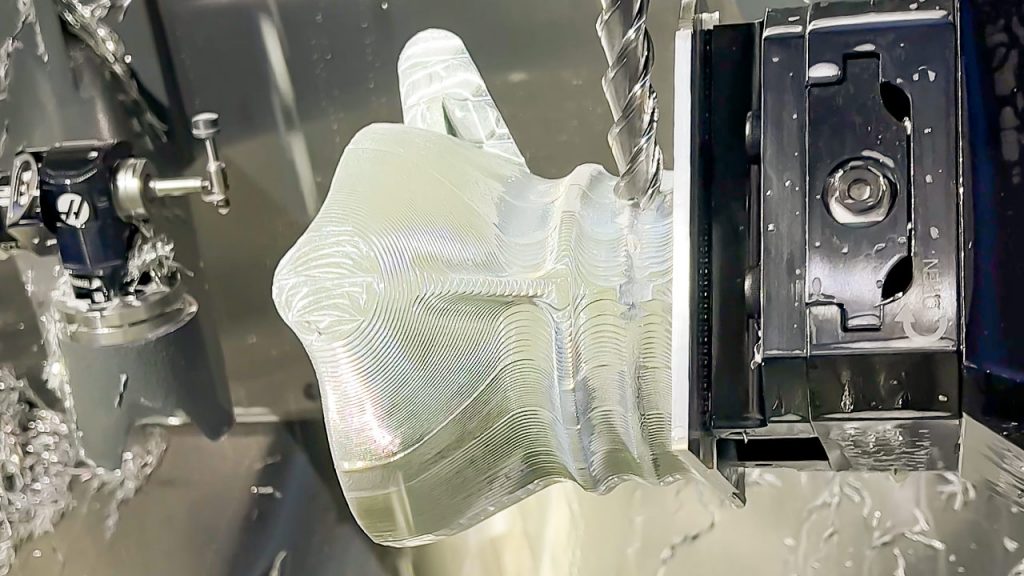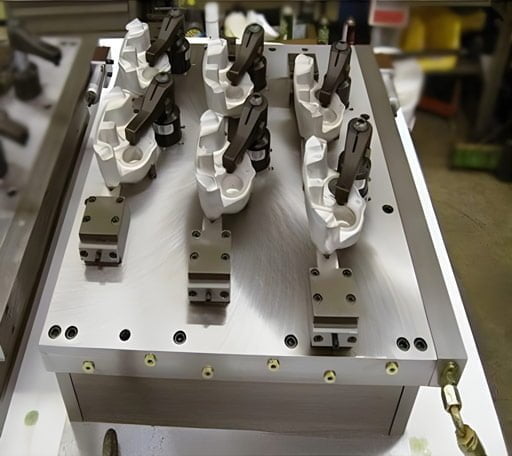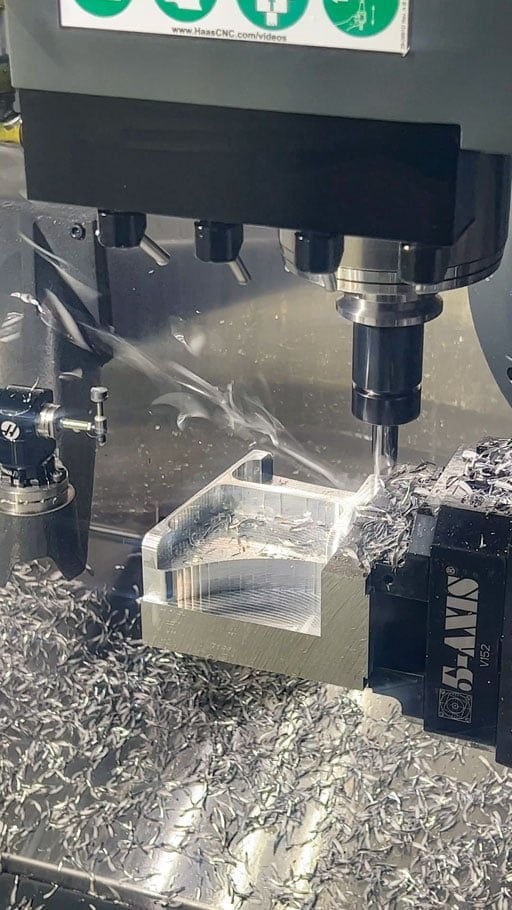生産需要にCNCマシンの使用をお考えですか?CNCマシンに慣れ親しんでいる場合でも、初めてCNCマシンを選択する場合でも、効率的な生産成果を達成するためには、マシンとそのツールを理解することが不可欠です。加えて、生産に関する決断を下すことはできません。 加工メーカーのようなものだ。 プロトツール必要なものを熟知していなければ。したがって、CNCマシンは様々なツールで構成されています。これらのツールは、それぞれ異なる機能と生産要件で使用されます。そのため、これらのツールがどのように機能し、どのような結果をもたらすのかを知らなければ、効果的な生産/カスタマイズの決定を下すことは困難となる。この記事では CNC治具 を進める前に、理想的なCNC治具を選ぶことができる。 CNC加工.続きを読む

CNC治具とは何か:
その前に CNC治具 CNC加工に適したものを選ぶには、そもそもCNC治具とは何かを知ることが不可欠です。正確に言えば、CNCフィクスチャーは安定性と配置のエージェントです。CNC機械加工における工具として使用され、いくつかの用途を持つワーク保持装置として知られています。
CNC冶具のこれらの用途は、ワークピースまたは製品をCNCマシンに適切に固定、支持、または取り付けることに基づいています。適合性と互換性を確保するための重要なツールとして、CNC治具があります。 CNC治具 は、CNCマシンの生産工程を管理・維持するために不可欠です。CNC治具を使用することで、生産工程は、生産要求や製品要件に従って、スムーズかつ効率的に処理することができます。
また、CNCワーク保持装置は、製造工程を通して人間が必要とする労力を軽減する。その結果、CNC加工におけるCNC治具の存在によって、手作業による投入とコストも削減される。このような理由から、多くの人々はCNC治具をCNC加工におけるもう一つの重要なツールである治具と関連付ける。しかし、これらは同じではありません。
治具がカッターの動きをガイドするのに対し、CNCワーク保持治具はカッターをガイドしません。その代わり、生産工程では、ワークピースを固定、支持、安定させるだけで、生産工程をミスのない、正確で効率的なものにします。さらに、CNCワーク保持冶具では、工具はワークと連動して移動する。対照的に、CNCマシンの治具は、工具を静止させます。
CNC治具の種類:
この先、パフォーマンスとコンセプトは CNC治具 は単純に見えるかもしれないが、それは限定されたものではない。動力源、加工作業、用途に基づいて、CNC加工で使用されるCNC治具にはさまざまなタイプがあります。以下、それぞれを詳しく探ってみよう:

用途に応じたCNC治具:
幅広いCNC治具の中で、これらの工具の一定量は、生産プロセスで提供するさまざまなタイプの用途と成果に基づいて使用されます。製品の種類や製造方法によって異なり、シンプルなものから、複雑なものまで様々です。 表面加工 への 金属表面仕上げ などなど、様々な選択肢があります。 CNC治具 その用途に応じて。以下は、このカテゴリーに分類される5種類のCNC治具である:
- 特別な備品:
特別なフィクスチャーとは CNC治具 特定のワークピース用に特別に設計されている。これらの治具は、特定のワークピースで使用される場合、安定性の面で大きな利点を提供します。これらのフィクスチャーはまた、CNC加工で使用する際に、より速く機能し、より簡単になります。
- ユニバーサル器具:
ユニバーサルCNCフィッティングは、どのようなワークにも使用でき、簡単に調整可能です。どのようなワークピースにも対応できるよう、フィクスチャーの各コンポーネントは調整および交換が可能です。その結果、ユニバーサル継手は、その名の通り、幅広い範囲と用途を持っています。どのようなワークピースにも対応し、さまざまなワークピースの管理と安定に役立ちます。 表面仕上げ方法 およびその他のタスク/プロセス。
- モジュラー器具:
モジュラー・フィクスチャーは、どのようなワークピースにも対応できるよう、素早く再構築し、再構成することができます。交換可能な部品でできており、さまざまなワークを扱うのに最適です。作業終了後は、フィクスチャーを取り外すことができます。モジュール式フィクスチャーは、より効率的で適応性の高い生産工程を提供します。
- コンビネーション・フィクスチャー:
このタイプ CNC治具 にはさまざまなサイズとスタイルがあります。そのため、機械設備に応じて様々なサイズや形状のワークを扱うのに最適です。
- 組み立て式備品:
ワークを評価した後、組み立てた固定具を使用することができる。その主な理由は、このタイプの治具にある。 CNC治具.このフィッティングは、ワークピースのニーズを満たすように設計されている。したがって、CNCマシンでこれらのフィクスチャーを組み立てるには、ユニークなアプローチが使用されます。さらに、状況に応じて、取り外したり、再利用したりすることができます。
電源に基づくCNC治具:
CNC機械加工で使用されるCNC治具の一般的なタイプには、機械のさまざまなタイプに適合するこれらの治具の動力源に基づいて、次のようなものがある:
- 電気器具
- 手動フィクスチャー
- 空気圧フィクスチャー
- 磁気固定具。
- 真空器具
- 油圧フィクスチャー
加工オプションに基づくCNC治具:
最後に、今日、さまざまなタイプの機械で使用されている幅広いCNC治具には、その構造や工具取り付けの設計に応じて、次のようなものがある:
- 回転治具
- フライス治具
- ボーリング治具
- 穴あけ治具
- 研磨治具
CNC加工プロセスに基づいて、CNC治具に関する貴重な結論を導き出すことができる。それは、固定具の使用を必要とするすべてのCNC加工手順には名前があるからです。例えば 表面仕上げ あるいは、主に 加工表面仕上げ を雇うことができる。 CNC治具 を支援する。 表面加工.同様に、特定の CNC治具 に使用できる。 金属表面仕上げ CNCマシン。
CNC加工のための正しいCNC治具の選択:

CNCフィクスチャーとその様々なタイプに慣れれば、どのタイプのCNCフィクスチャーを使うかをすぐに検討することができます。 CNC治具 は、どのアプリケーションの要求にうまく適合します。以下は、CNC加工に適したCNC治具を選ぶために、製造需要に応じて考慮できるいくつかの要因です:
- コンビネーションクリップ/ビルディングブロック
コンビネーションクランプは、しばしば"積み木クランプは、標準化されたデザイン、さまざまな機能、要件、サイズを持つ複数のクランプエレメントで構成されています。「ビルディングブロック」(さまざまな工作機械用治具)は、加工ニーズを満たすために容易に構築することができます。
モジュール式治具は、設計と製造の時間を最小限に抑え、生産準備時間を大幅に短縮し、小ロット生産サイクルを短縮し、生産効率を高めます。さらに、モジュール式フィクスチャーは、優れた位置決め精度、かなりの柔軟性、再利用可能なエネルギーと材料の節約、安価な使用コストを提供します。
- 油圧/空気圧グリップ:
油圧/空圧クランプは、油圧または空圧コンポーネントを動力源として使用し、ワークピースを位置決め、支持、圧縮する特殊なクランプです。
この固定具はワークの位置決め精度を確保し、加工精度が高く、位置決めとクランプ操作が迅速で、ワークのクランプが緩む時間を節約する。さらに、コンパクトな構造、マルチステーションクランプ、高速重切削、自動制御などの利点がある。これらの利点から、油圧/空圧クランプはCNC工作機械、マシニングセンター、フレキシブルな生産ライン、特に次のような場合に最適です。 大量処理.
- 永久磁石クリップ
電磁式永久磁石クランプは、最新の磁気回路コンセプトと、以下のような新しい永久磁石材料を利用して作られた新しいタイプのクランプである。 ネオジム鉄ボロン を磁気ソースとして使用する。クランプと解放の手順はおよそ1秒で、クランプ時間を大幅に短縮します。450Kgfを超える把持力により、このクランプは小規模から大規模の製造に適しています。
電磁永久磁石クランプは、クランプ時間、複数のクランプ時間、およびクランプ効率を大幅に削減することができる。さらに、多くの加工方法において、電磁永久磁石クランプは、加工時間を大幅に短縮できることが実証されています。 CNC治具 は、CNC工作機械やマシニングセンターの全体的な加工効率を大幅に向上させる可能性がある。
クランピングスピードの速さ、マルチステーションクランピングの容易さ、多面加工、安定した信頼性の高いクランピング、省エネルギー、自動制御などの利点があります。これらの利点により CNC治具 少量生産だけでなく、大量生産にも最適である。
- フィクスチャー・ベース:
滑らかなクランプシートは、特定の治具の製造サイクルと製造準備時間を効果的に最小化することができる。その結果 量産サイクル 生産効率を向上させます。同時に、カスタマイズ治具の生産コストを削減することができます。その結果、スムーズなクランプベースは、短いサイクルタイムでの大量生産に最適です。
結論
以上、CNC治具に関する詳細ガイドと、正しいCNC治具を選ぶために知っておくべきことでした。 CNC治具 エラーやデフォルトを発生させることなく、加工タスクを効果的に処理することができます。ご不明な点がございましたら、お気軽に下記までお問い合わせください。 プロフェッショナルに連絡する.










